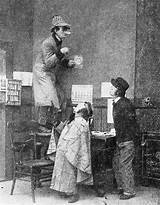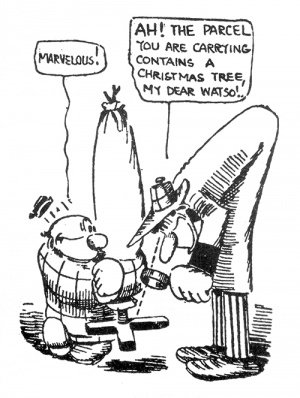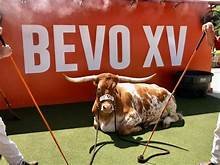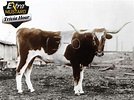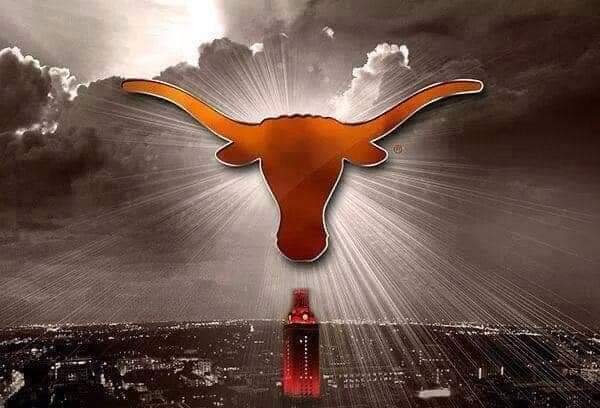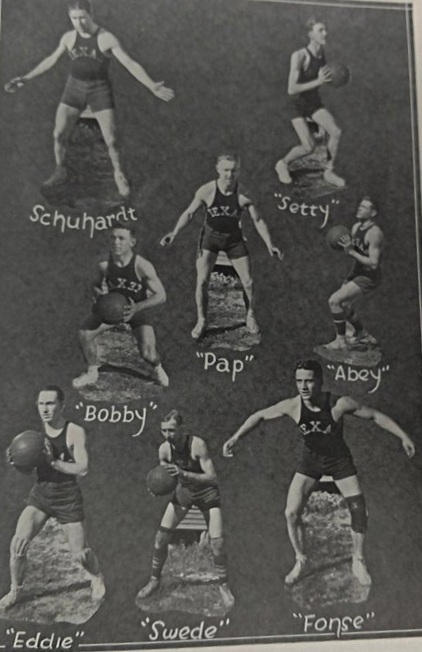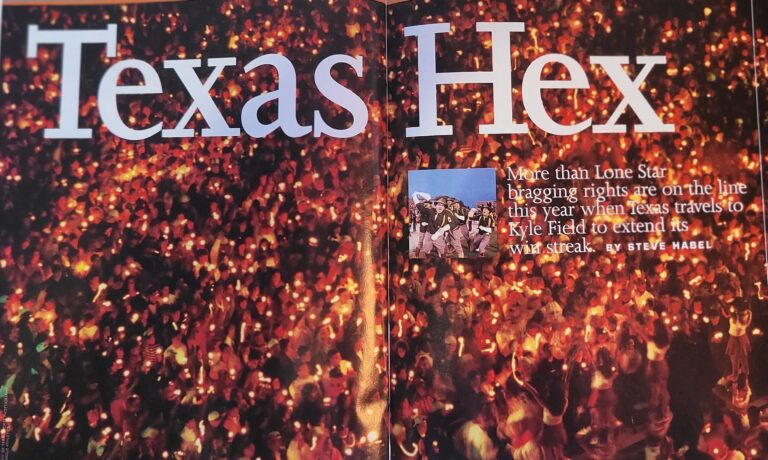The Road to Bevo -Folklore and Fables
Author Emma Schkloven in the title to an article she wrote in October 2022 for the Austin Monthly captures the history of Bevo in 32 words.
Bevo’s Long Ride to the Mascot Mountaintop
UT’s beloved icon may be living large now, but he’s faced kidnappings, hazings, and even the dinner plate before rising to big bull on campus.
By Emma Schkloven
The link to her article is below.
https://www.austinmonthly.com/bevos-long-ride-to-the-mascot-mountaintop/
TLSN agrees with Emma’a article and the rise and fall and rise and fall of Bevo as the heir apparent to the “Big Bull on Campus”.
A detailed history of a Longhorn named Bevo follows.
Cattle originally from Spain and Portugal were brought into Mexico in 1521. Stocked by the Mexican government in Presidios, these cattle ran wild between the Rio Grande and the Nueces rivers and north and east to the Louisiana border. These cows survived the adversity of predation, drought disease, and the dreaded tick fever. For two or three CENTURIES, these incredible wild cattle existed in a closed gene pool emerging as a unique breed, the Texas longhorn. They were extremely fertile, calving without problems well into their late teens, enabling the breed to multiply by the millions. Between 1866 and 1890, cattle drives delivered ten million Longhorns cattle to northern markets. Pulling the state of Texas out of bankruptcy and creating wealthy cattle barons and establishing Texas as a prosperous state.
How Bevo Got His Name by Alcalde
Contrary to campus mythology, Bevo didn’t get his name after A&M pranksters branded “13-0” into his hide. We know because the name first appeared in this very magazine a full two months before the branding took place. In the December 1916 issue of the Alcalde, editor Ben Dyer recounted the steer’s debut at the Thanksgiving game, writing simply, “His name is Bevo. Long may he reign!”
Regardless of its origins, it’s safe to say UT’s mascot was named by folks in Austin, not College Station. The name Bevo is all Longhorn.
THE TRUTH ABOUT BEVO BY JIM NICAR
It’s one of the best-known stories on campus. During a late night visit to Austin, a group of Texas Aggie pranksters branded the University’s first longhorn mascot “13 – 0,” the score of a football game won by Texas A & M. In order to save face, UT students altered the brand to read “Bevo” by changing the “13” to a “B,” the “-” to an “E,” and inserting a “V” between the dash and the “0.” For years, Aggies have proudly touted the stunt as the reason the steer acquired his name. But was the brand really changed? And is that why he’s called Bevo? Sorry, Aggies. Wrong on both counts.
Why did Ben Dyer dub the longhorn Bevo, instead of another name? For some time, the most popular theory has been that it was borrowed from the label of a new soft drink. “Bevo” was the name of a non-alcoholic “near beer” produced by the Anheuser-Busch brewery in Saint Louis. Introduced in 1916 as the national debate over Prohibition threatened the company’s welfare, the drink was extremely popular through the 1920s. Over 50 million cases were sold annually in fifty countries. Anheuser-Busch named the new drink “Bevo” as a play on the term “pivo,” the Bohemian word for beer.
However, while the Bevo drink was a long-term success, its sales in 1916 were comparatively small. Without the assistance of radio or television advertising, marketing campaigns were slower, and it took longer for retailers to buy in to the new Anheuser-Busch product. As it turns out, the Bevo beverage was almost unknown in Austin when Stephen Pinckney presented his orange longhorn to University students. Bevo the beverage just might be a red herring.
Beeves
Beeves is the old English plural of the word beef, a name applicable to all ruminating animals except camels, and especially to horned cattle . Horned cattle fit to plough. “Ye shall offer at your own will a male without blemish, of the BEEVES, of the sheep, or of the goats.” ( Leviticus 22:19 )
In addition, the term “beeve” is the plural of beef, but is more commonly used as a slang term for a cow (or steer) that’s destined to become food. The term is still used, though it was more common among the general public in the 1910s when Texas was more rural. The jump from “beeve” to “Bevo” isn’t far, and makes more sense given the slang and national fads of the time. In 1948 a letter from Travis at the Alamo refers to 20 or 30 head of Beeves. But today because of the gift of his collection by Phil Collins to the Alamo foundation we have the actual bill of sale signed by Travis for the Beeves! An incredible find that helps complete the story.
Sherlocko
A Recent Suggestion Made By Dan Zabcik (BA 1993) May Prove To Be The Right One. Through The 1900s And 1910s, Newspapers Ran A Series Of Comic Strips Drawn By Gus Mager. Charles Augustus Mager (1878–1956) , was an American painter, illustrator and cartoonist during the first half of the 20th century. He was the creator of several comic strips, notably Hawkshaw the Detective and Sherlocko the Monk. . Mager’s Strips Ran Every Sunday In Newspapers Throughout Texas, Including Austin.
.
The Strips Usually Featured Monkeys As Characters, All Named For Their Personality Traits. Braggo The Monk Constantly Made Empty Boasts, Sherlocko The Monk Was A Bumbling Detective, And So On. The Comic Strips Became So Popular, That For A While It Was A Nationwide Fad To Nickname Friends The Same Way, With An “O” Added To The End. The Marx Brothers Were So Named By Their Friends In Vaudeville: Groucho Was Moody, Harpo Played The Harp, And Chico Raised Chicks
For more on Longhorn mascot and logo history click on https://www.texaslsn.org/bevo, and https://www.texaslsn.org/searching-for-bevo-and-a-logo
ALCALDE SHARES THE THE HISTORY OF BEVO. See link above.
In September 2016 the Alcalde wrote an article on the history of Bevo. Please see the link below for more information.
http://alcalde.texasexes.org/bevoxv/?utm_source=attexas&utm_medium=email&utm_campaign=attexas
Alcalde states The biggest and most beloved mascot in college sports is, at present, napping under a grove of shady oak trees. An 18-month-old longhorn steer with a tawny orange hide and 40-inch horns still pink with new growth, he’s curled up next to his friend—another young steer named, for obvious reasons, Two Spot—with eyes closed and head lowered in the late-morning July heat.
Until he hears Betty coming, that is. Betty Baker parks the ATV she uses to get around her ranch, hops off with a nimbleness that belies her years, and walks through a tangle of thorns and brush toward the patch of grass where her prize steer sits. His orange ears swivel, his head lifts, and his dark doey eyes blink as she nears.
By the time you read this, this steer will be crowned Bevo XV, but for now his official name is still Sunrise Spur. To Betty, he will always be “punkin.” “My sweet baby!” she coos, proffering his favorite treat, a cube of hay. “It’s so good to see you.”
The Longhorn Who Will Be King rises to his feet, envelops the treat with his enormous pink tongue, and tilts his head so Betty can scratch between his ears. “Oh, I know,” she says. “You have a good life out here.”
He does indeed. His Majesty, as Betty’s husband John calls him, has 250 acres on which to roam at the Bakers’ ranch outside Austin. He enjoys a spacious pen, the company of other steers and cows—“Longhorns are sociable creatures,” John says—and all the hay he can eat. On Sept. 4, he will travel in the comfort of a custom-built, air-conditioned trailer to his spot outside the end zone of Darrell K Royal Memorial Stadium, delighting thousands of adoring fans.
There wasn’t supposed to be a new Bevo so soon. Longhorns often live well into their 20s, and everyone was shocked when Bevo XIV died suddenly of bovine leukemia last October at the age of 13. The search for his successor began immediately. “We wanted to take our time with this decision, because this is going to be the world’s most famous longhorn steer,” says Ricky Brennes, BS ’00, Life Member, executive director of the Silver Spurs Alumni Association, the spirit organization that handles Bevo. “We wanted to make sure that we got the very best for Texas.”
Brennes and his peers spent seven months searching for the next Bevo. They cast a wide net, visiting cattle shows, talking to breeders all around the state, and duly considering the hundreds of unsolicited emails, letters, tweets, and calls that poured in. “It seems like everybody with a few acres has a longhorn,” says Kevin Millin, ’73, who chaired the selection committee*. The Spurs fielded more than 100 inquiries from as far off as Oregon, Washington, Florida, Louisiana, and Maryland. Many candidates were swiftly eliminated because they were born out of state; the Spurs thought it only right that a native Texan fill the role. Others weren’t the perfect shade of burnt-orange—a rare color in longhorns, according to Betty Baker. “A lot of them are reddish or maroon,” she says, “and we certainly don’t want that.”
*Members of the Bevo XV selection committee include: Mike Frazier, Mike Grimm, Jason Craig, Lee Cavender, Kevin Millin, Ricky Brennes, Zach Mafrige, Brooks Beckelman, Bryant McKenzie, and Chase Koger.
The committee was also looking for a young, easy-to-train steer with a calm temperament. It is a lot to ask of an animal to attend more than 40 events per year, including standing in a noisy, chaotic football stadium before as many as 100,000 fans, and the majority of steers simply aren’t up to the task. The history of the mascot bears this out. Over the last century, Bevos have charged fans, photographers, and players; stampeded across the campus; kicked out their trailers; and otherwise asserted their wildness. These failures have been far less frequent in recent decades, now that the selection process is much more thorough than simply plucking a longhorn at random out of a herd, but they still serve as a reminder that steers are huge, powerful, and potentially dangerous creatures.
In November, Brennes brought six candidates to a Longhorn Band practice for an audition of sorts, to see how they would handle the noise and commotion. One stood out. “He was really good-looking,” Brennes remembers. “Great coloring, great disposition. We didn’t know yet what was in his future, but we kept an eye on him.” The steer went on to win the titles of junior champion and grand champion at a longhorn show, beating out much older and bigger competitors. He has exceptional conformation, a term that ranchers use to describe well-built animals that fit the standards of the breed. With his muscular build, well-formed horns, and hide spotted with just the right shade of orange, Bevo XV is a bovine Adonis. By May, the Spurs had made their decision. Another plus: He is owned by the Bakers, who also bred Bevos XIII and XIV, and thus are familiar with the unique challenges and responsibilities that come with a celebrity steer. “We looked everywhere,” Brennes says, “but John just seems to grow ’em on trees.”
The Bakers have spent the summer preparing Bevo XV for primetime. In addition to taking him to shows, they’ve hung flags in his pen (Bevo XIV was afraid of them), played him music on a boombox, and tossed a football near him in an effort to simulate the experiences he’ll have in the stadium. And the head-scratches, belly rubs, and praise that Betty bestows on him daily are more than just the sign of an adoring parent—they’re practice for the contact he will soon have with fans.
The walls of the Bakers’ home are lined with Bevo memorabilia and photos. Statues, signed game balls, plaques, and ribbons are everywhere. The stairway banisters glint with dozens of silver Bevo belt buckles. There’s a framed photo of Betty and John in their finest with Bevo XIII at George W. Bush’s inaugural presidential ball, and Betty and John with Bevo XIV at the 2005 national championship. “Where he goes, we go,” John says.
Bevo XV is one of the youngest steers to ever take the field for Texas. When the season kicks off, he will still have his baby teeth. It’ll be an adjustment for fans who were used to the much larger Bevo XIV, and there will surely be some good-natured teasing. But a young mascot also seems fitting for Charlie Strong’s young team. “I like the idea of people getting to watch him grow up with the team,” says Brennes. “In a way, he belongs to the fans. He belongs to Texas.”
100 Years plus years Of the road to Bevo
1916
THE FIRST BEVO MAKES HIS DEBUT AT THE THANKSGIVING DAY UT VS. A&M GAME.
To date, there have been fifteen Bevos. Bevo was originally named “Bo” but came to be called Bevo soon after his first appearance at Texas’ 1916 Thanksgiving Day game.
Alumnus Stephen Pinckney, who first suggested the idea of a live Longhorn mascot, had participated in West Texas cattle raids in his previous job with the U.S. Attorney General’s office. A stolen steer from Laredo with an orange hide caught his eye, so Pinckney raised $125 in $1 donations from alumni to buy the steer and ship it to Austin by rail. At halftime, a group of Texas Exes dragged the frightened 1,200-pound Longhorn onto the field. The Daily Texan would later describe him as “the most recalcitrant freshman ever bulldozed into higher education.” Traumatized and unprepared for a public appearance, Bevo I left at halftime. UT won the game 21-7, but a Longhorn as the team mascot would not be considered again for the next 20 years.
While 13-0 to “Bevo” is not true it is part of Longhorn folklore.
In 1916, a group of Aggies escaped the prison farm known as College Station, using the stealth of night to descend upon the University of Texas campus known as the 40 acres. These criminals crept to the stables where our beloved longhorn mascot was corralled. In a narcissistic showing of meaningless pride after their 13-0 victory over Texas during the 1915 football game between these two schools, these criminals made off with our mascot. These cattle rustlers and felons took the longhorn to Waco where they branded him with the score – “13-0.”
The University of Texas, a school that instills values, compassion and respect for others turned the other cheek rather than retaliate. From this criminal act, when the Texas students finally found its steer, they modified the “13-0” to look like “Bevo.” Bevo, our beloved mascot, reigns as a sense of pride to our storied football program, unmatched by any other school mascot in the nation. It was on this day that Bevo was born.
It should be noted that in 1916, Texas went on to annihilate A&M with a score of 21-7. Although it is unproven, I believe that Baylor University was complicit in the crime, as Bevo was located in Waco. Certainly, an Aggie is not smart enough to throw suspicion towards the Baylor Bears on their own by depositing our longhorn in Waco, which leads me to conclude that Baylor was a part of the heist.
Mark Walters
1917
Pig Bellmont. Briscoe Center for American History
UT GETS ITS FIRST MASCOT—NOT A LONGHORN, BUT A WHITE-AND-TAN DOG NAMED PIG BELLMONT.
Pig was named after L. Theo Bellmont, the university’s first athletics director, as well as Gus “Pig” Dittmar, who played center on the football team. Bellmont brought Pig to work with him, and the friendly pup soon developed a reputation around the campus. Much like A&M’s Reveille does today, Pig often went to classes and campus events in addition to football games. A custom letter “T” was even affixed to his collar, designating him as an official UT letterman. Sadly, Pig’s reign ended when he was struck by a Ford Model T on Jan. 1, 1923.
The idea to use a live longhorn as the university’s mascot is attributed to UT alumnus Stephen Pinckney in 1916. Pinckney gathered $124 from other alumni to purchase a steer in the Texas Panhandle, which they originally named “Bo” and shipped to Austin.
A Longhorn steer was not the original mascot of the University of Texas. The original mascot was actually an American Pit Bull Terrier named “Pig”.[
1920
1920 BEVO1 was the main course at a dinner banquet.
With the care of the first Bevo at a ranch near Austin costing the university a then-hefty 60 cents per day, and his temperament too unstable for a safe return to football games, UT officials made the decision to slaughter the unfortunate steer. He was fattened up, barbecued, and eaten at the January 1920 football banquet. In attendance were 100 UT lettermen and invited Aggie guests, who were presented with the hide they had branded “13-0” after beating UT the previous year.
The invitation to the 1920 football banquet promised guests that Bevo’s “juicy steaks will be awaiting your appetite.” Briscoe Center for American History
1936
BEVO II GETS BANNED
Like his predecessor, Bevo II had a temper—which is why he appeared in public only four times. The first was at the pep rally before the 1936 UT vs. SMU game when more than 4,200 students cheered on his introduction outside Gregory Gym. At the game the next day, though, he kicked out the sides of his trailer. UT students alleged that the incident was the fault of an SMU yell leader, who hit the steer on the head with a megaphone. After nearly escaping, he was promptly removed from the stadium “to the relief of the crowd and the team,” as the Alcalde noted.
Some speculated that Bevo II was actually a Hereford rather than a longhorn since he had unusually short horns, but today we don’t know for sure. Regardless, in December, the Athletic Council voted 5-1 to ban him from the stadium permanently, and Bevo II was sent back home to the Diamond T Ranch.
Even though a Longhorn was banned from games , the 1941 team had this photo made with a Longhorn with no name.
1945-48
BEVO III
After 13 years without a mascot, the university decided to try again—this time, with a longhorn from the San Antonio Zoo. Things finally went a little better. Bevo III began his career at the Texas Tech game, which UT won 33-0, and he went on to lead the Longhorns to their third consecutive Southwest Conference championship. He was also the first Bevo cared for by the Silver Spurs, who have managed the mascot ever since.
Still, after three years, his temperament was proving to be too much of a challenge. He was a “rip-snorting, fence-busting steer. After he charged a photographer, escaped his pen, and stampeded around campus, Bevo III was returned to the San Antonio zoo.
1949
BEVO IV
The Daily Texan called Bevo IV, an 8-year-old steer who hailed from Fort Griffin State Historic Site in Breckenridge, “the meanest of them all” and “just about the biggest, wildest, rarin’-est steer you’ve ever seen.” While 11 handlers led him into the stadium for his first appearance, he rammed a parked car. Later that year, he made an impressive leap over an 8-foot fence. After just one season, it was back to Fort Griffin for him.
1950-55
Bevo I was fattened up, barbecued, and eaten at the January 1920 football banquet—not just by 100 UT lettermen, but also by invited Aggie guests, who were presented with the hide they had branded “13-0”.
BEVO V
After past failures, the Silver Spurs decided to try raising their next Bevo from calfhood instead of attempting to train a full-grown steer. The strategy worked. Bevo V was known for his calm demeanor, and he served for five years. He was also the first to travel with the team, heading to South Bend, Indiana, for the Notre Dame game. Never mind that he kicked a caretaker while in an unfamiliar stable on that trip; it was just an aberration for this otherwise zen-like longhorn.
1955-57
BEVO VI
Bevo VI is best-known for charging the Rice bench during a game—a feat which the Longhorns cheered on. He only lasted two seasons.
1957-64
BEVO VII
Bevo VII
Bevo VII arrived on campus at the same time as new coach Darrell K Royal, who would go on to become UT’s winningest football coach of all time, racking up three national championships, 11 Southwest Conference championships, and 167 wins. Just as the team’s star rose, so too did Bevo’s: Bevo VII was the most beloved, calmest mascot to fill the role yet. He even kept his cool when the Aggies kidnapped him in 1963. The Spurs called in the Texas Rangers to help in the search, eventually locating him in College Station. When word got out, a mob of jeering Aggies blocked his trailer in the street as he underwent a veterinary exam in Bryan. Luckily, he was unharmed, and that Saturday the Horns beat the Aggies, 15-13.
Make it stand out
Whatever it is, the way you tell your story online can make all the difference.
1965
BEVO VIII
Nicknamed “Old Will” (it’s unclear why), this Bevo was donated by former UT regent Major S.R. Parten, and was so feisty that he lasted only one season on the job.
1966
BEVO IX and Reveille III were introduced at the 1966 game.
The longest-serving steer at the time, this mascot was well-behaved, except for one quirk: He didn’t like being around women. Bevo IX was also kidnapped twice in 1972, by both the Owls and the Aggies. He helped the Longhorns win the 1969 and 1970 national championships.
Bevo IX amused fans by leaving his mark atop the Nebraska Cornhuskers logo on the field during the Big 12 title game.
1976-80
BEVO X
This Bevo hailed from the Hardin Ranch outside Vernon and was known for his hatred of the color red and the smell of perfume. In a game against Houston in 1972, he took an accidental hit from Earl Campbell. “To this day, I think I am the only one to knock Bevo down,” Campbell would later recall.
1981
Bevo XI was never meant to be a permanent mascot but rather a temporary one until his successor was fully grown. They even appeared together at the 1981 Texas Tech game.
1982-88
BEVO XII
Bevo XII and his handlers circa 1982-84. Briscoe Center for American History
Bevo XII’s behavior was said to be unpredictable, a problem that only worsened over his six years on the field. In 1987 his trailer flipped in an accident on the MoPac Expressway, and he was never the same.
1988-2004
BEVO XIII
Another famous moment came in 1996, when he amused fans by leaving his mark atop the Nebraska Cornhuskers’ logo on the field during the Big 12 title game in St. Louis.
Possibly the most beloved Bevo of all time, this long-serving creature was the first bred by John and Betty Baker, who also provided both his successors. Dubbed the “Gentleman Bevo” by the Daily Texan , he was serene enough to cheer up sick kids at the Brackenridge Children’s Hospital. But his most impressive appearance was at President George W. Bush’s inaugural ball in 2001.
not happy with his handler
2004-2015
After Bevo XIV’s retirement was announced in fall 2015, the Silver Spurs brought the Golden Hat trophy on a visit to his ranch. Texas Athletics
BEVO XIV
Known originally as Sunrise Studly, Bevo XIV was a gentle soul from the time he started the job at age 2. He even obediently rolled onto his back for belly rubs when owner Betty Baker (who preferred to call him “Baby”) approached his stall. With an impressive 6-foot hornspan, he consumed some 60 pounds of food per day. Bevo XIV’s reign included the 2005 national championship. He was also a social animal, known for sticking close to his best friend, another steer named Sunrise Spike. Like his predecessor, he attended a Bush inauguration, and he also was kind enough to invite Reveille to his ranch for some time together.
The two got along great, Betty Baker later told the Alcalde. “She never once barked at him, and he never tried to hook her,” she said. Sadly, Bevo XIV died from a rare case of bovine leukemia during the 2015 season, and the search for his replacement began immediately.
Link to Hook’em Bevo scratching where it itches is below.
https://www.facebook.com/lauri.armstrong/videos/10217233704531562/







